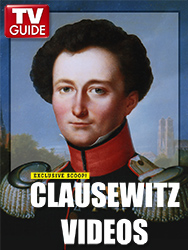
Fifty+ videos making reference to Clausewitz are listed in this "Clausewitz Videos" section. Some of these have actual educational value—in too many cases, unfortunately, by demonstrating common misunderstandings. Others are merely amusing (or not even that). They are listed in no particular order of importance.
(THIS PAGE) — • — |
|
ADDITIONAL PAGES Academic Lectures and Interviews by Prominent Clausewitz Scholars |
|
This is a guide to some pop-culture references to Clausewitz that might be useful bits for lectures or presentations—especially if you are looking to fulfill the U.S. War Colleges' mandatory "Monty Python video requirement" for discussions on strategic theory. |
|
Clausewitz at the Pentagon, 2015 In 2015, then-Under Secretary of Defense for Personnel and Readiness Brad R. Carson invited several prominent Clausewitz scholars to give a series of lectures, which culminated in a panel discussion involving Carsion and six of the series participants. We have 4 full-length classes by individual speakers and the full panel discussion. |
|
Clausewitz's writing were not intended to become doctrine, but they are certainly relevant to doctrine. Explaining the relevance can be done well or poorly. |
OLDER STUFF
Return to Main Videos Page
● COMBAT STUDIES INSTITUTE. "Lesson 4. Clausewitz and Jomini."
This video was designed to help instructors at the US Army Command and General Staff College in the early 1990s (possibly earlier) at Fort Leavenworth prepare to instruct their students on these two theorists in a course on the evolution of modern warfare. The discussants are Roger Spiller, Sam Lewis, and George Gawrych. This discussion now seems quaint on many fronts—the treatment of Clausewitz and 'guerrilla' or 'people's war' is particularly weak. (Background info provided by John Kuehn via Jon Sumida.)
● 2001. Christopher Bassford on Clausewitz, excerpts 1-4. This is a series of 4 short talking-head videos done for the US Army War College in July 2001 by Dr. Christopher Bassford. Clausewitz.com hopes to redo and expand this series, which suffers from some doctrine-driven oversimplifications, from some youthful misconceptions, and from Bassford's now rather unfashionable glasses. (Click link or image to view video.)
a. "Clausewitz's Dialectical Method." (3:29) This video focuses on Clausewitz's rather formal dialectical discussion of the nature of war in Book I Chapter, 1, rather than on the much more casual dialectical method that pervades the rest of his book On War.
b. "Categories of War." (6:29) This video discusses the terms "Absolute (or Ideal) War," "Real War," "Limited War," and "Unlimited War." Inactuality, Clausewitz never used the terms "limited war," "unlimited war," or "total war," and "real war" is often misinterpreted to mean some very particular "type" of war (genuinely at the high end of resources and violence committed). "Real war" in Vom Kriege actually refers simply to war in the various and messy ways in which it occurs in the real world). The term "unlimited war" used in this video was chosen for convenience and to avoid excessive "hair-splitting" in a pretty rudimentary course. In retrospect, this was an error. Better terms (still not exactly Clausewitz's own phrasing) would be "war of limited objectives" and "war with the aim of rendering our opponent politically and/or militarily helpless." but keep in mind that these phrases describe only one side's objectives in a war. The opponent's political objectives may be quite different, and their military objectives—which must always be considered as distinct from the political objectives—do not necessarily fall into the same classifications. These terms do not really describe "types" of war in the wholistic, multilateral sense; rather, they describe types of political and military objectives, and these are by definition unilateral. the variety with which war manifests itself in the real world flows to a great degree from the manner in which these unilateral aims interact.
For the latest (c.2023) development of Bassford's argument, particularly its assault on the traditional conflation of the "ideal war" of Book I with "absolute war" (which is confined to the first half of Book VIII and was written much earlier in Clausewitz's intellectual evolution), see Christopher Bassford, "Clausewitz's Categories of War and the Supersession of 'Absolute War.'"
c. "From the Dialectic to the Trinity." (7:19) This video describes how Clausewitz's thesis (War is nothing but an act of force....) and his antithesis (War is merely an expression of politics....) feed into his synthesis, the "fascinating trinity" of war. (Note that our translation varies—for good reasons—from the standard Howard/Paret version. Wrestling with the precise meaning of the German term "wunderliche Dreifaltigkeit" is an intriguing undertaking. (Or an infuriating one, if you haven't come to understand yet that such wrestling is the only way to appreciate the rich complexity of the universe. And it's fun!)
d. "Demonstration of Clausewitz's Trinity Imagery." (Randomly Oscillating Magnetic Pendulum). (2:32) The larger ROMP video below gives a better view of the device in action but has no voice overlay describing what you're looking at. For a deeper explanation, see Christopher Bassford, "Tiptoe Through the Trinity, or, The Strange Persistence of Trinitarian Warfare." If you really want to go deep, read Alan D. Beyerchen's brilliant "Clausewitz, Nonlinearity and the Unpredictability of War," International Security, 17:3 (Winter, 1992), pp. 59-90. [HTML backup]
